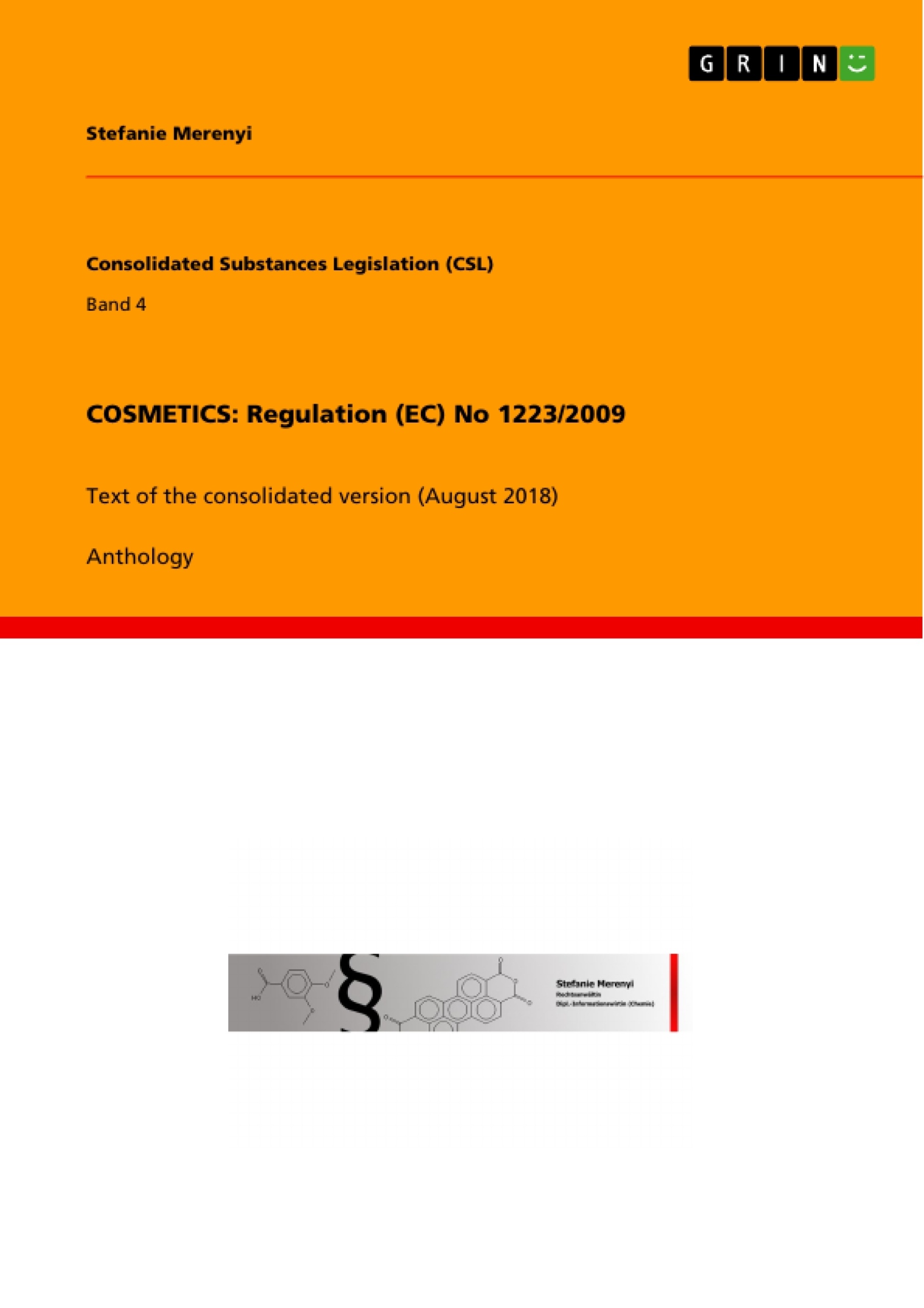Chemicals legislation is quite a vivid regulatory arena. As is the case in the science of Chemistry itself there is also no standstill in chemicals legislation. Most of the relevant regulations are subject to chronic revisions. In order to keep up with the actual legislation beyond the efforts of a loose-leaf collection, the series CSL: Consolidated Substances Legislation has been created. This is the consolidated version of the European Cosmetics Regulation (August 2018).
Table of Contents
- Preface
- Consolidated version of REGULATION (EC) No 1223/2009 OF THE EUROPEAN PARLIAMENT AND OF THE COUNCIL of 30 November 2009 on cosmetic products (recast) last amended by Commission Regulation (EU) 2018/978 of 9 July 2018
Objectives and Key Themes
This publication aims to provide a consolidated and up-to-date version of the European Union's Regulation (EC) No 1223/2009 on cosmetic products, including all amendments up to July 9, 2018. It seeks to simplify access to this complex legislation and reduce the need for extensive research across multiple amendments.
- Consolidated Cosmetics Regulation
- Amendments and Updates to Regulation (EC) No 1223/2009
- Accessibility of Cosmetics Legislation
- European Union Cosmetics Law
Chapter Summaries
Preface: The preface explains the dynamic nature of chemicals legislation, highlighting the constant revisions and updates. It introduces the "Consolidated Substances Legislation" (CSL) series, designed to provide users with readily accessible and consolidated legal texts, incorporating all amendments directly into the original regulation. The preface emphasizes the importance and far-reaching impact of substances legislation, affecting everyone directly, and positions the CSL series as a novel approach to accessing this complex field.
Consolidated version of REGULATION (EC) No 1223/2009 OF THE EUROPEAN PARLIAMENT AND OF THE COUNCIL of 30 November 2009 on cosmetic products (recast) last amended by Commission Regulation (EU) 2018/978 of 9 July 2018: This section presents the fully updated and consolidated text of Regulation (EC) No 1223/2009, incorporating all amendments up to Commission Regulation (EU) 2018/978. The consolidation aims to provide a single, comprehensive source for all relevant legal provisions governing cosmetic products within the European Union. This ensures users have access to the most current and accurate legal framework without needing to consult multiple documents and amendments separately. The integration of all changes streamlines access and interpretation of the regulation, reducing ambiguity and facilitating compliance.
Keywords
Cosmetics Regulation, EU law, Regulation (EC) No 1223/2009, Consolidated Legislation, Cosmetic Products, Chemicals Legislation, Legal Compliance, European Union.
Frequently Asked Questions: Consolidated Version of Regulation (EC) No 1223/2009
What is this publication about?
This publication provides a consolidated and up-to-date version of the European Union's Regulation (EC) No 1223/2009 on cosmetic products, including all amendments up to July 9, 2018. It aims to simplify access to this complex legislation.
What does the publication include?
The publication includes a table of contents, objectives and key themes, chapter summaries (for the Preface and the consolidated regulation), and keywords. The main content is the fully updated and consolidated text of Regulation (EC) No 1223/2009 itself.
What are the key themes addressed in the publication?
Key themes include a consolidated cosmetics regulation, amendments and updates to Regulation (EC) No 1223/2009, accessibility of cosmetics legislation, and European Union cosmetics law.
What is the purpose of consolidating the regulation?
Consolidating the regulation simplifies access to the legal text by incorporating all amendments into a single document. This reduces the need to consult multiple documents and amendments separately, improving clarity and facilitating compliance.
What is covered in the Preface?
The preface explains the dynamic nature of chemicals legislation and introduces the "Consolidated Substances Legislation" (CSL) series. It highlights the importance and far-reaching impact of substances legislation and positions the CSL series as a solution to accessing this complex field.
What is the content of the consolidated Regulation (EC) No 1223/2009 section?
This section presents the fully updated and consolidated text of Regulation (EC) No 1223/2009, incorporating all amendments up to Commission Regulation (EU) 2018/978. It aims to provide a single, comprehensive source for all relevant legal provisions governing cosmetic products within the European Union.
What are the key words associated with this publication?
Key words include: Cosmetics Regulation, EU law, Regulation (EC) No 1223/2009, Consolidated Legislation, Cosmetic Products, Chemicals Legislation, Legal Compliance, and European Union.
Who is the intended audience for this publication?
The intended audience is anyone needing to access and understand the current legal framework for cosmetic products within the European Union. This includes businesses, legal professionals, and researchers.
Where can I find the full text of the consolidated regulation?
The full text of the consolidated Regulation (EC) No 1223/2009 is included within this publication. (Note: This FAQ only provides a preview; the full text would be found in the complete publication.)
- Quote paper
- Stefanie Merenyi (Author), 2018, COSMETICS: Regulation (EC) No 1223/2009, Munich, GRIN Verlag, https://www.grin.com/document/274383



